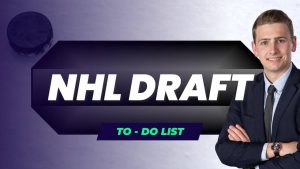[vc_row][vc_column][vc_column_text]
In a previous article – How much of their salary do NHL players keep? – I outlined a rule of thumb for players to assume they’ll only have 40% of their stated salary as cash they can use. For example, if they have a salary of $3 million, they should budget for $1.2 million. The next question is: How much of that 40% should they save and invest?
The Answer
That depends. NHL salaries vary substantially, so there isn’t a one-size-fits-all financial planning solution. However, I’m a big fan of trying to simplify things into a language players can understand. So, I figured that illustrating what life could look like for a player if they save and invest 20% of their salary might be helpful.
Lets Take A Look
Looking at current NHL salaries and using a “good” player as my proxy (a player who is a relevant NHL player but not a superstar), I’ll use the following estimates for career earnings:
- Entry-Level Contract
- 3 years at $925,000
- Second Contract
- 4 years at $4,000,000
- Final Contract
- 8 years at $6,000,000
This career earning trajectory is fair for a player who is drafted relatively high, plays a substantial role on his team (i.e., a top 6 forward/top 4 D), plays in the league for 15 years, but isn’t a superstar talent.
Let’s see what financial life could look like for this player if they save 20% of their salary and invest it in the Dimensional Global Equity Portfolio, to which we’ll apply an expected return of 8%**.
For this example, we will assume all the assets are invested in a taxable account, ignoring the tax-advantaged accounts such as the RRSP, TFSA, IRA, and Roth IRA. The average tax rate is 50%, and inflation is 3.00%.
Entry Level Contract
The target savings amount for the first three years in the league would be $185,000 per year.
[/vc_column_text][dt_fancy_image image_id=”8814″ width=”1000″ css=”.vc_custom_1660326001577{padding-top: 20px !important;padding-bottom: 20px !important;}”][vc_column_text]*Source: Custom Table – Navi Plan – Adam Henry
By the end of their first deal, they’d have $577,496 in their investment account.
Second Contract
Once they’ve signed the second deal, the target savings amount would be $800,000 annually.[/vc_column_text][dt_fancy_image image_id=”8815″ width=”1000″ css=”.vc_custom_1660326113824{padding-top: 20px !important;padding-bottom: 20px !important;}”][vc_column_text]*Source: Custom Table – Navi Plan – Adam Henry
By the completion of their second contract, they’d have $4,072,760 in their investment account.
Final Contract
For their final contract, the target savings amount would be $1.2 million per year. The contributions are more significant, and since they’ve already established a large balance, this is where we’ll see compounding really do its thing.[/vc_column_text][dt_fancy_image image_id=”8816″ width=”1000″ css=”.vc_custom_1660326177921{padding-top: 20px !important;padding-bottom: 20px !important;}”][vc_column_text]*Source: Custom Table – Navi Plan – Adam Henry
At the end of their career, they will have accumulated $16,630,925, which they can use to fund their lifestyle now that the playing cheque is no longer coming in.
Pension & Retirement Income
In my article – The NHL Pension – I outlined the current defined benefit pension plan in the CBA. In my above example, this player would have earned the maximum pension because they played longer than ten years. Therefore, at age 62, they can begin collecting their $255,000 annual benefit.
Because this player was successful in saving while they were young and had a plan in place, they now have the opportunity to create an income stream from their investments to bridge the gap between the day they play their final game and the day they receive their first pension cheque.
If they wanted to create a consistent cash flow that mirrors what the pension will pay, they could begin withdrawing $255,000 per year at age 33 from their investment account, indexed at 3% to keep pace with inflation, and ending at age 62 as follows.[/vc_column_text][dt_fancy_image image_id=”8817″ width=”1000″ css=”.vc_custom_1660325844428{padding-top: 20px !important;padding-bottom: 20px !important;}”][vc_column_text]*Source: Custom Table – Navi Plan – Adam Henry
As you can see, the investment account will continue to grow even though we begin making the $255,000 withdrawals. Since the balance of the account is large enough, creating $255,000 of income only represents an approximately 1.5% withdrawal of the total balance. Assuming the investments within the account earn more than 1.5%, the account will continue to grow! This represents the power of compounding.
Summary
The above scenario is hypothetical, and because there are numerous variables (investment returns, inflation, taxes, etc.), it is unlikely that any player’s situation will ever look exactly like this. However, the overall principle to take away is this:
If you play in the NHL and save and invest 20% of what you make, you will likely experience financial freedom and create intergenerational wealth for your family.
An important thing to consider is that income does not mean wealth. Just because your salary is large does not guarantee you’ll accumulate wealth. That takes planning, action, and discipline.
If you’d like to see projections based on your current salary and forecasts on how things could look based on where you are currently at in your career, schedule a call with our team, and we’d be happy to show you how you’re positioned.
**Actual, realized returns may vary[/vc_column_text][/vc_column][/vc_row]






